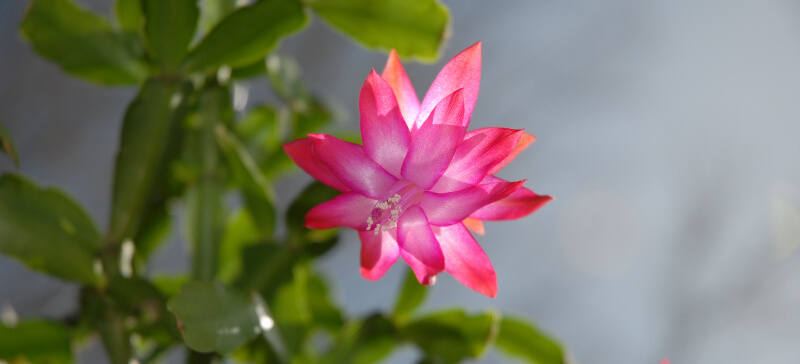Today’s topic is When To Bring In Christmas Cactus From Outside. Obviously, you can find a great deal of Types Of Christmas Cactus-related content online. The proliferation of online platforms has streamlined our access to information.
There is a connection between the Can You Plant Christmas Cactus In The Ground and How To Get Christmas Cactus To Bloom information. additional searching needs to be done for Should Christmas Cactus Be Inside Or Outside, which will also be related to How To Get Christmas Cactus To Bloom.

19 Tips to When To Bring In Christmas Cactus From Outside | What Temperature Is Too Hot For Christmas Cactus
- Temperature-wise, the holiday cactus is a bit picky. During its peak growth months (April to September), it prefers balmy temperatures between 70 and 80 degrees Fahrenheit. Once the buds are set, it requires low nighttime temperatures (between 55 and 65 degrees Fahrenheit) and at least 13 hours of darkness to form buds that will flower. Keep it away from heating vents, frequently-opened doors, and drafty windows; this plant does not like to be exposed to sudden drafts or temperature changes and it will drop its buds or flowers if it’s unhappy. - Source: Internet
- A holiday cactus likes sun or shade, but you have to take care not to give it too much of either one. Holiday cacti prefer partial shade or diffused light, although they are adaptable to other conditions. If you expose them to full sunlight, ensure it’s during the winter months; too much sunlight in the spring and summer can cause the plant to become pale and yellow. - Source: Internet
- This plant blooms close to the end of November with showy flower colors that are either red, pink, peach, purple, orange, or white. It has very pointed and claw-shaped projections on the edges of its leaves. Christmas cactus (Schlumbergera russelliana): Often bred with S. truncata to form Schlumbergera x buckleyi, this species blooms close to the end of December with magenta and white flowers. It has flattened leaf segments that are rounded with a few notches around the edges. - Source: Internet
- Though it is a cactus, its tropical origins make this plant crave more water than most. Water the plant thoroughly, allowing excess water to run out through the drainage holes. Let the soil dry almost completely between waterings. You will know if the soil is too dry when the leaves start to pucker and shrivel. - Source: Internet
- Prune a holiday cactus right after it blooms, when it enters a new growth period extending its growth segments. Pruning will force the plant to branch out, and it will grow more of its distinctive stems. You can also prune safely from after bloom to late spring without harming the plant. - Source: Internet
- Taking care of a holiday cactus is a little trickier than most other desert-loving cacti that are drought resistant. The holiday cactus is a tropical rainforest native and needs regular water to remain healthy. The flattened leaves are stemmed segments that hang and drape from containers and hanging baskets. Flowers form at the ends of the stems—so the more stems your plant has, the more flowers it will have. Traditionally, the cactus blooms red, but it can produce flowers that are pink, white, magenta, or purple, or the less common colors of salmon, peach, and orange. - Source: Internet
- The most common pests that infect holiday cacti are fungus gnats, flower thrips, aphids, spider mites, and mealybugs. Do not overwater your plant; soggy soil is what most often attracts these pests. Insecticidal soap and horticultural oil are usually effective in controlling an outbreak. The tiny pests can also be removed by blotting them with an alcohol-soaked cotton ball. A holiday cactus might not survive a heavy infestation and might need to be discarded, especially if there are other plants nearby. - Source: Internet
- Schlumbergera x buckleyi is a hybrid plant often called by other names such as Thanksgiving, Christmas, or Easter cactus. They look alike but bloom at different times and have slight differences in the shape of their leaves. Because of their subtle differences, they are often mislabeled in garden centers. - Source: Internet
- The best time to propagate a holiday cactus is one to two months after it’s finished blooming. Avoid propagating it in the fall while it sets its buds and as it’s actively flowering. Taking cuttings of holiday cactus, large or small, will help the original plant grow fuller and bushier, resulting in more blooms in the future. Holiday cactus is best propagated from stem cuttings. - Source: Internet
- Often bred with S. truncata to form Schlumbergera x buckleyi, this species blooms close to the end of December with magenta and white flowers. It has flattened leaf segments that are rounded with a few notches around the edges. Easter cactus (Rhipsalidopsis gaetneri): This variety starts to reveal star-shaped flower buds in February and flowers from March through May. It has tiny bristles on the edges of its rounded leaf segments. - Source: Internet
- If you notice that your holiday cactus has stunted or distorted growth, inspect it closely for a mealybug infestation. Mealybugs look like tiny white cotton dots about 1/8 to 1/4 inches long. They move slowly and often appear first low on the leaf surface in the dark, warm, moist areas near the center stem of the cactus. The insects feed on plant sap and leave a sticky honeydew substance behind, which causes mold to form on the plant. - Source: Internet
- Common Name Christmas cactus, holiday cactus, crab cactus Botanical Name Schlumbergera x buckleyi Family Cactaceae Plant Type Succulent, cactus, perennial Mature Size 6–12 in. tall, 12–24 in. wide Sun Exposure Partial Soil Type Moist, well-drained, loamy Soil pH Neutral, acidic Bloom Time Fall, winter Flower Color Pink, red, white, purple, orange Hardiness Zones 10–12 (USDA) Native Area South America - Source: Internet
- If the leaves of your holiday cactus turn red or pink, it might either be receiving too much sun or too little water. If your plant is located in a window with direct sun, move it back to indirect light. If the soil is dried up to 1 inch deep, water it more frequently. The rule of thumb is to water a holiday cactus when the top of the soil feels dry. - Source: Internet
- The best pots for cactus plants are terra cotta or clay pots. These pots are porous and wick away water from plants that can be harmed by overwatering. The pot should have many drainage holes or one large one at the bottom. - Source: Internet
- Under the best conditions, plants bloom about 18 months after sowing from seed. Each flower will remain open for at least six days, and the plant should continue to bloom for four to six weeks. The holiday cactus colors are showy but the flowers are scentless. The best way to ensure that your holiday cactus remains in bloom throughout the winter is by removing the faded flowers or deadheading. - Source: Internet
- Soil is not an essential factor for the holiday cactus; it’s adaptable to most soil conditions and grows naturally as an epiphyte in its native region. Yours can thrive in loamy, sandy, perlite, cactus mix, or general-purpose potting soil. To achieve optimal growth, it prefers a pH level between 5.5 and 6.2; peat moss is a helpful additive for a more acidic environment. - Source: Internet
- To prune a holiday cactus, give the stems a twist between one of the segments. You can also use a sharp, sterilized knife or scissors to remove segments. You can remove up to a third of the plant per year or, more conservatively, trim off one to two segments from the end of each stem. - Source: Internet
- Feed your holiday cactus monthly with a half-strength, diluted water-soluble balanced fertilizer during the early spring and summer months. Once you’ve noticed the formation of flower buds—usually late summer or early fall—stop feeding. After the plant blooms, you can resume monthly feedings. - Source: Internet
- You can harvest cactus seeds from the pods (fruits) of the plant. If the pods are still green, wait until they turn red. The pod transformation usually happens in the fall. Extract the brownish-black seeds and wash the pulp away. - Source: Internet
 Following are some suggestions for where to begin your search for data on when to put christmas cactus outside:
You should try to find How to Care for Holiday Cactus (Christmas Cactus)-related information from reputable places. Libraries, online resources, and even paid journalists all fall under this category.
- It's crucial to be aware of the various electronic media sources available when researching Why Are The Leaves On My Christmas Cactus Limp?, such as Google and YouTube. You may also get info about When To Stop Watering Christmas Cactus on social media sites like Facebook and Twitter.
Following are some suggestions for where to begin your search for data on when to put christmas cactus outside:
You should try to find How to Care for Holiday Cactus (Christmas Cactus)-related information from reputable places. Libraries, online resources, and even paid journalists all fall under this category.
- It's crucial to be aware of the various electronic media sources available when researching Why Are The Leaves On My Christmas Cactus Limp?, such as Google and YouTube. You may also get info about When To Stop Watering Christmas Cactus on social media sites like Facebook and Twitter.It’s crucial to read to examine the authenticity of each source in order to acquire the greatest information regarding Should Christmas Cactus Be Inside Or Outside.
Video | When To Bring In Christmas Cactus From Outside
You’ll learn more about Can You Plant Christmas Cactus In The Ground after watching the films included in this post, which come from a variety of different sources. Information on a wide range of topics can be easily accessed via the internet.
## Notable features of Christmas Cactus Indoor Care include:- When To Bring In Christmas Cactus From Outside
- When To Put Christmas Cactus Outside
- When To Stop Watering Christmas Cactus
- Should Christmas Cactus Be Inside Or Outside
- Why Are The Leaves On My Christmas Cactus Limp?

With the abundance of Can You Plant Christmas Cactus In The Ground-related resources available online, it’s easy to find what you’re looking for.
This is not how most people would expect to learn more about Types Of Christmas Cactus, so be prepared for some shock value. It paves the way for a closer examination of the Should Christmas Cactus Be Inside Or Outside information’s actual substance and its potential applications.
 techniques for making Types Of Christmas Cactus data visualizations that are both aesthetically pleasing and practically applicable. They can spread the word about when to bring in christmas cactus from outside in professional and promotional settings. For this reason, we also include Can You Plant Christmas Cactus In The Ground-related pictures.
techniques for making Types Of Christmas Cactus data visualizations that are both aesthetically pleasing and practically applicable. They can spread the word about when to bring in christmas cactus from outside in professional and promotional settings. For this reason, we also include Can You Plant Christmas Cactus In The Ground-related pictures.
At last, this article sums up key points about Christmas Cactus Indoor Care. There is also a comparison of your Christmas Cactus Indoor Care knowledge to that of Should Christmas Cactus Be Inside Or Outside, as well as a discussion on Can You Plant Christmas Cactus In The Ground and Can You Plant Christmas Cactus In The Ground.